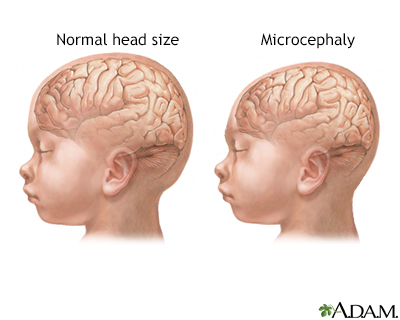Microcephaly
Microcephaly is a condition in which a person's head size is much smaller than that of others of the same age and sex. Head size is measured as the distance around the top of the head. A smaller than normal size is determined using standardized charts of head circumference.
Images



I Would Like to Learn About:
Causes
Microcephaly most often occurs because the brain does not grow at a normal rate. The growth of the skull is determined by brain growth. Brain growth takes place while a baby is in the womb and during infancy.
Conditions that affect brain growth can cause smaller than normal head size. These include infections, genetic disorders, and severe malnutrition.
Genetic conditions that cause microcephaly include:
- Cornelia de Lange syndrome
- Cri du chat syndrome
- Down syndrome
- Rubinstein-Taybi syndrome
- Seckel syndrome
- Smith-Lemli-Opitz syndrome
- Trisomy 18
- Trisomy 21
Other problems that may lead to microcephaly include:
- Uncontrolled phenylketonuria (PKU) in the mother
- Methylmercury poisoning
- Congenital rubella
- Congenital toxoplasmosis
- Congenital cytomegalovirus (CMV)
- Use of certain drugs during pregnancy, especially alcohol and phenytoin
Becoming infected with the Zika virus while pregnant can also cause microcephaly. The Zika virus has been found in Africa, the South Pacific, tropical regions of Asia, and in Brazil and other parts of South America, along with Mexico, Central America, and the Caribbean.
When to Contact a Medical Professional
Most often, microcephaly is diagnosed at birth or during routine well-baby exams. Talk to your health care provider if you think your infant's head size is too small or not growing normally.
Contact your provider if you or your partner has been to an area where Zika is present and you are pregnant or thinking about becoming pregnant.
What to Expect at Your Office Visit
Most of the time, microcephaly is discovered during a routine exam. Head measurements are part of all well-baby exams for the first 18 months. This takes only a few seconds while a measuring tape is placed around the infant's head.
The provider will keep a record over time to determine:
- What is the head circumference?
- Is the head growing at a slower rate than the body?
- What other symptoms are there?
It may also be helpful to keep your own records of your baby's growth. Talk to your provider if you notice that the baby's head growth seems to be slowing down.
If your provider diagnoses your child with microcephaly, you should note it in your child's personal medical records.
References
Antoniou E, Orovou E, Sarella A, et al. Zika virus and the risk of developing microcephaly in infants: a systematic review. Int J Environ Res Public Health. 2020;17(11):3806. PMID: 32471131 pubmed.ncbi.nlm.nih.gov/32471131/.
Centers for Disease Control and Prevention website. Zika virus. www.cdc.gov/zika/index.html. Updated May 31, 2024. Accessed June 19, 2024.
Kinsman SL, Johnston MV. Congenital anomalies of the central nervous system. In: Kliegman RM, St. Geme JW, Blum NJ, Shah SS, Tasker RC, Wilson KM, eds. Nelson Textbook of Pediatrics. 21st ed. Philadelphia, PA: Elsevier; 2020:chap 609.
Marcdante KJ, Kliegman RM, Schuh AM. Congenital malformations of the central nervous system. In: Marcdante KJ, Kliegman RM, Schuh AM, eds. Nelson Essentials of Pediatrics. 9th ed. Philadelphia, PA: Elsevier; 2023:chap 187.
Mizaa GM, Dobyns WB. Disorders of brain size. In: Swaiman KF, Ashwal S, Ferriero DM, et al, eds. Swaiman's Pediatric Neurology: Principles and Practice. 6th ed. Philadelphia, PA: Elsevier; 2017:chap 28.
BACK TO TOPReview Date: 11/6/2023
Reviewed By: Neil K. Kaneshiro, MD, MHA, Clinical Professor of Pediatrics, University of Washington School of Medicine, Seattle, WA. Also reviewed by David C. Dugdale, MD, Medical Director, Brenda Conaway, Editorial Director, and the A.D.A.M. Editorial team.

Health Content Provider
06/01/2025
|
A.D.A.M., Inc. is accredited by URAC, for Health Content Provider (www.urac.org). URAC's accreditation program is an independent audit to verify that A.D.A.M. follows rigorous standards of quality and accountability. A.D.A.M. is among the first to achieve this important distinction for online health information and services. Learn more about A.D.A.M.'s editorial policy, editorial process and privacy policy. A.D.A.M. is also a founding member of Hi-Ethics. This site complied with the HONcode standard for trustworthy health information from 1995 to 2022, after which HON (Health On the Net, a not-for-profit organization that promoted transparent and reliable health information online) was discontinued. |
The information provided herein should not be used during any medical emergency or for the diagnosis or treatment of any medical condition. A licensed medical professional should be consulted for diagnosis and treatment of any and all medical conditions. Links to other sites are provided for information only -- they do not constitute endorsements of those other sites. © 1997- 2025 A.D.A.M., a business unit of Ebix, Inc. Any duplication or distribution of the information contained herein is strictly prohibited.
